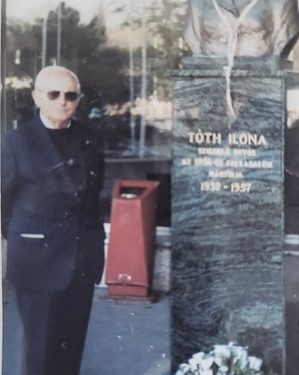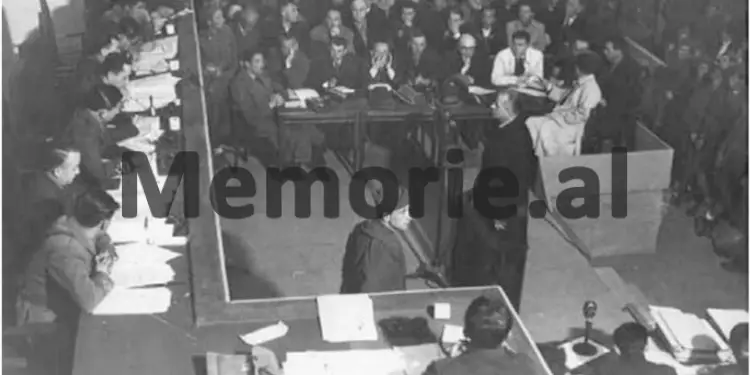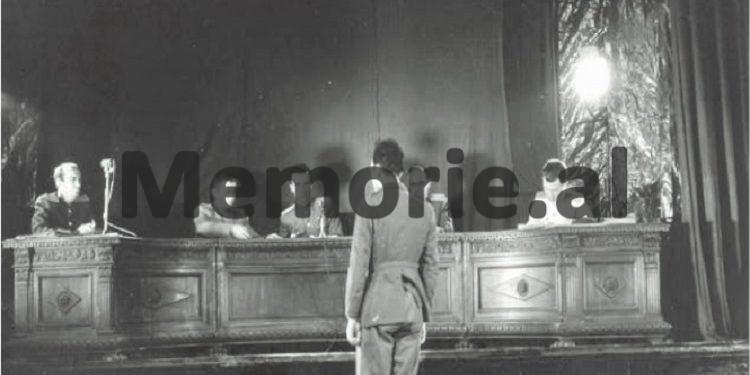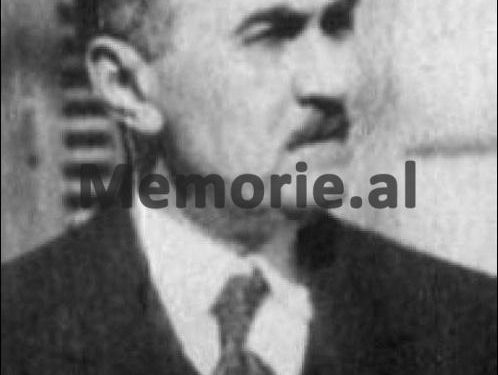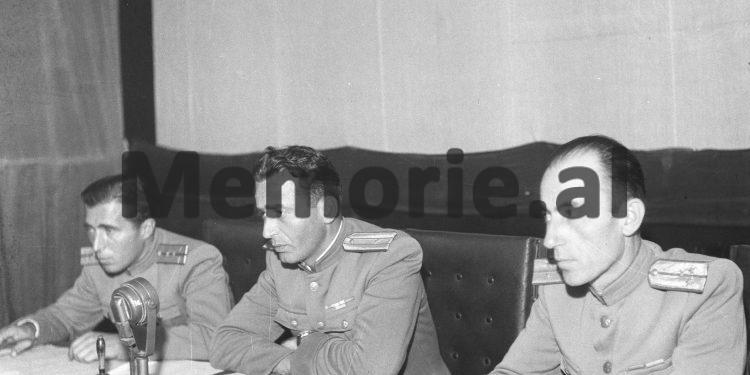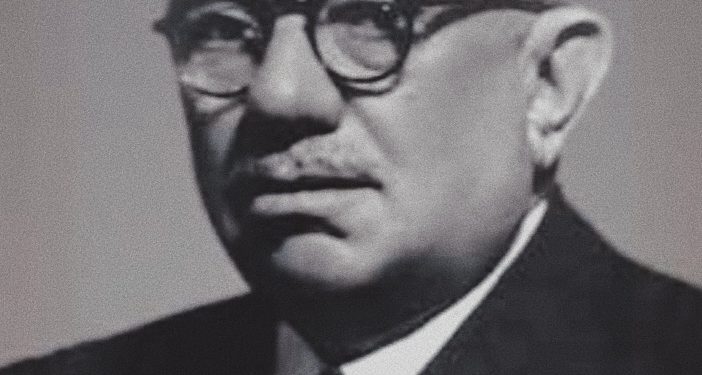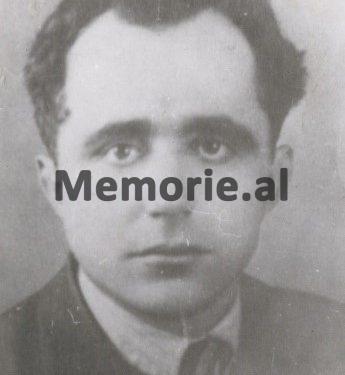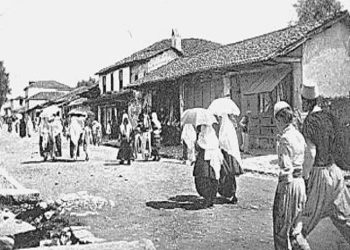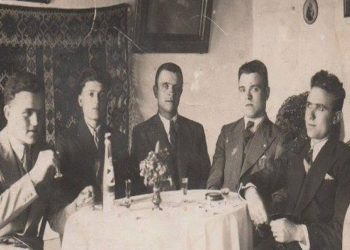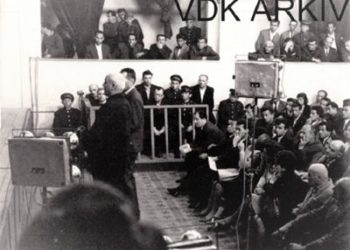From Agim Musta
Memorie.al / On the fourth anniversary of the passing away of the well-known historian, researcher, writer and publicist Agim Musta, (July 24, 2019), former political prisoner, his daughters Elizabeta and Suela, gave him the right to exclusivity for the publication, by the online media Memorie.al, of one of the author’s most prominent publications, such as the ‘Black Book of Albanian Communism’. This work contains numerous data, evidence, facts, statistics and arguments unknown to the general public, on communist crimes and terror in Albania, especially against intellectuals, in the period 1945-1991. The publication for the first time of parts of this book is also the realization of one of the bequests of the historian Agim Musta, who, from the beginning of 1991 until he passed away, for nearly three decades was engaged with all his powers, working to raise collective memory, through book publications and publications in the daily press. All that voluminous work of Mr. Agim Musta, concretized in several books, is a contribution of great value to the disclosure of the crimes of the communist regime of Enver Hoxha and his successor, Ramiz Alia. A good part of the publications of Mr. Agim Musta, is also translated into English. Thanking the two daughters of the late Musta, who chose Memorie.al, to commemorate their father, from today we are starting the publication, part by part, of the “Black Book of Albanian Communism”.
Continues from last issue
-The prisons of the Albanian communist state-
(1945-1991)
The death camps
How many people were executed in Albania during the years of communist terror, no one knows for sure, but the places where most of them were shot are known and named by the people as “death camps”. People kidnapped from the street on the outskirts of cities have been killed. Partisans were killed in the arms, in the ravines and valleys, buried by the villagers, without ever learning who they were. Innocent people were killed, without a court decision, not registered in any document, whose names appear alive in the civil status offices, and no one knows where they are buried!
Citizens have been killed trying to cross the border and their bodies have been burned by the commandos of the border posts sprayed with oil. People have been executed at the stake and their corpses have been thrown into the abyss, where even wild beasts cannot tread. Citizens were shot by the streams and rivers and their corpses ended up in seas and lakes. Prisoners have died in the Security cells of the prisons and the lifeless bodies have been thrown into the trash heaps of the cities. During the years 1945-1948, in most cases, the executions of “enemies” were done during the day, to instill terror in the citizens.
This is how 17 dignitaries of the Albanian state were executed in Tirana in May 1945, in broad daylight, at the place called “Priest’s Hill”, a few meters to the right of the Porcelain Factory. Two days before the execution, City Hall workers, under the supervision of Security officers, had dug a not very deep pit. Not a week after the execution, the pit was discovered by grave robbers, who remembered that the important persons shot would have valuables, but left in disappointment, leaving the corpses uncovered, out of anger, as the killers, before shooting them, had robbed them of everything of value.
At the beginning of 1950, the (Kobze) Ministry of the Interior ordered that every branch of the Security in the districts had “death camps”. In Tirana, there were several killing fields, but the most important ones were by the Tërkuza and Erzen rivers. Hundreds of victims were executed there. Many of the corpses were taken from the murky waters of the rivers, or eaten by birds, or torn apart by wild animals. Tog-words; “Riverbank”, became synonymous with death. When someone seriously cursed someone, he said; “The village on the river bank”.
Another execution range in Tirana was near the Farka Bridge, on the Erzen River. This is what my fellow sufferer, Nuri Stepa, who worked as a driver before he was sentenced, told me: “I was traveling from Elbasan to Tirana, with the car loaded with olives. Before crossing the Farka Bridge, a policeman signaled me to stop on the spot and put out the lights. I obeyed the order and foresaw that something extraordinary was about to happen across the bridge. It was 11.00 at night. Although the moon was dim, across the bridge I could make out the outlines of a “Gaz”, the Security and the car -prison. From “Gaz”, several people got off and from the auto-prison, two people sat on the ground, who were holding the policemen by the arms. After them, from the door of the auto-prison, they threw on the ground like a bag of salt, a third person, who was dragged by his feet. He would probably have died, during transport by auto-burg, from a heart attack. In Zallishte, near the foot of the bridge, the two victims were executed, shooting them with bullet, behind the head.
Then the three corpses were kicked and thrown into a pit, near a thicket near the bridge. On top of the corpses, they threw something white, like lime powder. With a shovel, they threw some sand and gravel and left for the cars. “Gazi” and the auto-prison turned towards Tirana and the policeman who was at the tail of the bridge got on the motorbike and he also started towards Tirana. I was so shocked by the macabre execution I saw that night that when I took hold of the steering wheel, my hands were still shaking. Ten years have passed since that night and that scene remains in my memory as if it had happened last night.”
In the years of pluralism, many skeletons of shot people were found by the river Erzen, like the pit of 22 executed people, near Beshiri Bridge, 12 km. in the southwest of Tirana, in February 1951, on the occasion of the so-called “incident” at the Soviet Embassy. In Tirana, executions were also carried out at the Sharkë Bridge, near Vora, in the tunnels of Qesarka, on Malin me Gropa, near the Brari bridge and in some other place, not identified to date. In Shkodër, the most important anti-communist bastion in Albania, Zalli i Kiri, from Bardhaj to the Kir river bridge, was designated as the place of execution.
In that cursed place, hundreds of innocent people were executed, especially during the years 1945-1946, after the “cleansing operation” in Malesin e Madhe and the failure of the Postriba Uprising. Executions were also carried out along the banks of the Buna River, near the Cement Factory, where often the corpses buried during the rains came to the surface, or were taken by the waves of the river. There have been cases where corpses have been left on the surface, without being buried, thrown on top of each other, as happened after the failure of the Postriba Uprising. This was done with the aim of terrorizing the people, and to terrorize the inhabitants of those parts and Shkodra. The expression; “to be killed in Zall i Kiri”, became proverbial in Shkodër and symbolized death by bullet.
In Vlora, the “death camps” were located at “Bishti i kaldrēmi”, along the Vlora-Kanina road, in barns near the Brick Factory and near a small bridge, by the national road, without going to Qafa e Koçiu. That bridge was called by the people of Vlora, “The Bridge of Ballists”. Several hundred gunmen, convicted and unconvicted, were executed there by the “people’s courts” of the communist dictatorship. Even to this day, every honest Albanian who passes near this bridge remembers those men who were killed, for the sole fault, that they wanted Albania. In Gjirokastër, the executions were carried out in “Sheshin e Zinxhirîve” and in Buduk, on the banks of the Drino River. In Berat, the death ranges were located in Uznovë, as well as near Moravë village, on the banks of the Osum River. In Durrës, the executions were carried out in Porto-Romano and Bisht t Palla. This is what my fellow sufferer, Dervish Sulo, former prosecutor of Durrës, told me during the fifties:
“Those sentenced to death, we executed in Porto-Romano. Once there was a leather processing factory there and there were many pits, where they had thrown leather waste decomposed by acids. So, it was not necessary to open new pits, for the corpses of the executed. We brought “Gaz” close to a pit, took down the man to be executed, placed him in front of the searchlights of the auto-prison, tied hands and feet, and executed him from behind, with a machine gun or a revolver. When the person to be executed was important, we also took the doctor of the Internal Affairs Department with us, to make a written report on the person who was annihilated.
In most cases, the doctor signed the next day, without coming to the death row. When the person to be executed was physically strong and too aggressive, in order not to cause trouble, he was given a “dry execution” inside the cell, by shooting him behind the head with an iron crowbar, without making a sound or a sound. , they took him to the place of execution. After the murder, I was called as the prosecutor and the doctor of the Interior Department, to draw up the report of the execution, which was allegedly drawn up in the death range of Porto-Romano. Late at night, the corpse was thrown in the pits of Porto Romano, and was immediately absorbed by the waste of the factory. Within a very short time, it completely decomposed.”
According to the General of the Security, Halim Xhelo, who was imprisoned in 1966 and after a few years was found hanging in the prison-hospital of Tirana, after 1948, for the disappearance of the corpses of the executed people, slaked lime was used, which over time, it decomposed not only the corpse, but also the bones of the victims. Halim Xhelo claimed that many corpses of murdered people were used as cadavers in the Faculty of Medicine at the University of Tirana and were also sold outside Albania, to university hospital clinics.
In the prison-hell of Burrel, the “frontline” of Albanian intellectuals during the years 1946-1990, more than 350 prisoners died, most of who were prominent intellectuals, graduates of the best universities in Europe and America. Every prisoner who died of hunger, disease, cruel treatment, was wrapped in an old blanket and thrown into a pit, located a few tens of meters behind the prison, near a cherry tree.
The pit was covered with beams and planks and a thin layer of soil was laid over them. Whenever a prisoner died, his corpse was taken out of the prison after dark and thrown into the common pit. On the corpse, they threw a quantity of quicklime powder. Cherry, this wonderful tree, which the Japanese keep as a symbol of happiness, for the prisoners of Burrel, crossed the barbed wire borders of Albania and became an inspiration for a Hungarian filmmaker, who escaped to the West, for the realization of a feature film with the title; “Cherry”.
Unfortunately, in Albania, the “Cherry” of Burrel Prison is not known. In 1990, to eradicate all traces of the crime, the farm bulldozer leveled everything behind the prison, leaving no trace of the common corpse pit. In the years of pluralism, the families of the victims tried in vain to find even a bone of their relatives who died in that cruel prison.
In the district of Korça, in the stream of Shipskë village, during the years of pluralism, dozens of corpses of people executed by the communists, during the years 1943-1944, were found. In the limbs of the skeletons, rusty nails are clearly visible, which clearly shows that the victims were cruelly tortured before being executed and were nailed like Christ in Golgotha. In the Maliqi marsh, in the district of Korça, for the drying of which during the years 1946-1950, several thousand political prisoners worked, those who died from hard work, from torture and diseases, were not buried, but thrown into swamp scum.
In autumn, when the prisoners were sent to the prisons from which they had come, the raging rains that brought abundant waters, carrying with them the mud of the swamp and the decomposed corpses, came to the surface. They were attracted by the dogs of the villages around the marsh, becoming a terror to the villagers and the subject of ludicrous legends.
In the Bulqiza mine prison camp, during the years 1947-1957, several hundred political convicts worked alongside ordinary prisoners. They removed them from Bulqiza, when the Hungarian Revolution broke out, for fear of the outbreak of a mass revolt, by the prisoners. In the prison camp of Bulqiza, during the 43 years of exploitation of the mine with prisoners, more than 700 people have died.
Suffice it to mention that on one day in 1969, from the collapse of a gallery, 17 prisoners died. For those unfortunates, not a word was said during the red dictatorship. The necropolis of Bulqiza, the largest of Albania’s prison camps and prisons, was razed before the communist coup d’état. The rape of corpses by the Communists was used to exploit the hatred of the “inverted classes” and to promote the cannibalistic “entertainment” of the brainless mobs.
In Berat, in September 1943, football was played with the severed head of the former deputy of the Albanian Parliament, Hysni Toskës, in the neighborhood “Murat Çelebi”, while the bones of the former Albanian prime minister of 1920, Iljaz Vrioni, who died in 1932, were taken out of the grave and walked through the streets of the city, with howls, like wolves and jackals. In Shkodër, the grave of our national poet, Gergj Fishta, was destroyed and his bones were thrown into the Buna River to end up in the Adriatic. The rape of graves and corpses was the “working method” of the communist system, to terrorize the community and erase the national memory.
Special courts, for the punishment of anti-communist Albanians
In the first months of 1945, in the ten centers of the prefectures of Albania, Special Military Courts were established, for the punishment of thousands of anti-communist Albanians, or “war criminals”, as they were labeled. In most cases, the presidents and prosecutors of these courts were: tinsmiths, farriers, nurses, criminals, born sadists and some highly educated intellectual, thirsty for blood and career.
Special Court of Tirana
The most sensational trial began in Tirana on March 2, 1945. The President of the Trial was the tinsmith Koçi Xoxe, (lieutenant general), with government function, vice/prime minister, semi-illiterate, of Slavic-Macedonian origin. The prosecutor was Bedri Spahiu, former lieutenant of the monarchist army, with secondary military education, mentioned for the crimes committed during the period 1941-1944, in the 1st Operative Zone, Vlorë-Gjirokastër. The members of the judging panel were high functionaries of the party-state such as: Halim Budo, Hysni Kapo, Beqir Balluku, Faik Shehu, Medar Shtylla, Gago Floqi and a former partisan from the village of Boboshtice.
In the dock were 60 defendants, some of whom were participants in the Quisling government, leaders of the “Balli Kombëtar” and “Legality” parties, but there were also honest and pious patriots who had sacrificed a lot for Albania and the Albanian nation. The participants, as listeners in the courtroom, were invited by party functionaries – state, secretaries of party organizations, representatives of Albanian women, communist youth, trade unions and others, to cheer during the sessions judicial.
The trial took place in the cinema “Kosova” (former People’s Theatre). In the small square in front of the “Kosova” cinema, there was always a red-eyed, bloodthirsty crowd, constantly shouting the slogans: “Traitors on the rope”, “Reactionaries on the machete” and singing hoarsely: “Reactionaries like a mouse, Bedri Spahiu judges them”.
In the courtroom and outside it, a suffocating atmosphere had been created, all anxiety and fear. The trial was broadcast live from dozens of loudspeakers, which were placed in the main squares and streets of Tirana. The people didn’t even dare to open their mouths to say a word of mercy to any defendant. For 43 days, as long as the court sessions continued, for the members of the defendants’ families and for honest people, they were terrifying days; whereas for the communists, their sympathizers and the bottoms of the Albanian society, who were happy with the misfortune of others, it was a day of joy…!
Shipirt-Kazem prosecutor, Bedri Spahiu, in his claim of April 6, 1945, asked for the death penalty for 23 defendants, while with the court’s decision (non-appealable), which was given on April 14, 17 were sentenced to death by firing squad defendant.
They were:
- Javer Hurshiti, (1880-1945), originally from the Caucasus, former deputy, prefect and minister.
- Fejzi Alizoti, (1868-1945), former deputy, mayor, senator and minister.
- Kol Tromara, (1887-1945), pure nationalist, former deputy, one of the leaders of the “National Front”.
- Kostandin Kote, (1896-1945) former official and minister.
- Hilmi Leka, (1913-1945), former official and minister.
- Reshit Mërlika, (1912-1945, merchant and entrepreneur.
- Ismail Golemi, (1908-1945), former officer and commander of the “National Front”, for Gjirokastra.
- Tahsin Bishqemi, (1897-1945), lieutenant colonel, former general commander of the Albanian Gendarmerie.
- Terenc Toçi, (1912-1945), native of Calabria, former minister and speaker of the Albanian Parliament.
- Zef Kadarja, (1898-1945), former prefect and high official.
- Shyqyri Borshi, (1883-1945) former senior officer of the Albanian state.
- Beqir Valteri, (1893-1945) former Minister of Popular Culture in 1943. (Assassin of Ahmet Zogut in 1923).
- Bahri Omari (1888-1945), former director of the “Dielli” newspaper of the “Vatra” Society in the USA, exponent of the “National Front” and foreign minister of the Albanian state in 1943-’44.
- Dik Cami, (1905-1945), former officer of the Albanian Gendarmerie.
- Aqif Përmeti, (1884-1945), former captain of the American army and adjutant of General Pershing, before World War I, general of the Albanian Army in 1943-’44.
- Daut Çarçani, (1902-1945), former officer of the Gendarmerie and prefect of the Albanian state.
- Gustav Myrdash, (1882-1945), Austrian general, former adviser to the Albanian Army and adjutant of King Zog.
They were sentenced to heavy prison terms:
- Koço Kota, former prime minister.
- Ibrahim Bicaku, former prime minister.
- Xhevat Korça, former minister.
- Qemal Vrioni, former minister.
- Et’hem Cara, former minister.
- Jakov Milaj, former minister.
- Ndoc Naraçi, former minister.
- Tefik Mborja, former minister.
- Musa Gjylbegu, former minister.
- Mihal Zallari, former Speaker of the Parliament.
- Koço Tasi, former senior official.
- Rifat Begolli, former senior employee.
- Shuk Gurakuqi, former senior official.
- Sokra Dodbiba, former senior civil servant.
- Anton Kozmaci, former senior employee.
- Mihal Sherko, former senior employee.
- Akile Tasi, former senior official.
- Fiqiri Llagami, former journalist.
- Lazar Radi, former publicist.
- Xhevit Leskoviku, former Chief of Staff of the Albanian Army.
- Sami Koka, colonel, former senior officer, Deputy Chief of Staff of the Albanian Army.
- Sulejman Vuciterna, colonel, former senior officer
- Bajram Pustina, colonel, former senior officer
They were sentenced from 1 to 10 years of imprisonment: Tefik Mbroja, Gjergji Bubani, Bilal Nivica; Ismet Kryeziu, Vangjel Goxhomani, Ihsan Libohova, Zef Benusi, Mahmut Golemi, Zija Bejleri, Emin Toro, Manush Peshkepia, Ded Jakova, Zenel Prodani, Sami Visoka, Abedin Xhiku, Zef Shiroka, Luigi Filaj, Abdurrahman Telqiu and Qemal Vrioni. Memorie.al
The next issue follows




